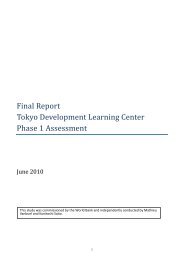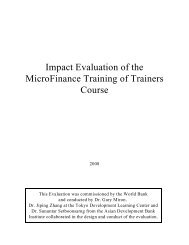Shakeel Qadir Khan
Shakeel Qadir Khan
Shakeel Qadir Khan
Create successful ePaper yourself
Turn your PDF publications into a flip-book with our unique Google optimized e-Paper software.
Pakistan<br />
Post Crisis Damage and Needs Assessment<br />
Immediate Restoration and Medium Term Reconstruction in<br />
Crisis Affected Areas of NWFP and FATA<br />
Presentation by:<br />
<strong>Shakeel</strong> <strong>Qadir</strong> <strong>Khan</strong> (Director General)<br />
North-West Frontier Province Provincial Disaster Management Authority<br />
Government of Pakistan
Genesis of Crisis; State & Multilateral Response<br />
• Geo-Political Fallouts of War on Terrorism on Pakistan<br />
– Proliferation of Militant Non-State Actors and Weapons in specific regions<br />
resulting in challenges to State Writ and Territorial Control<br />
– General Worsening of Law and Order and Retaliatory Attacks by Extremists<br />
• State Response, Developments and Bank Engagement since Mar 2009<br />
– Major military operations since Mar/April 2009 to reassert state writ and fight<br />
militancy<br />
– Mass internal displacement – initial round of around 2 million IDPs, followed<br />
by more displacement recently in the wake of continued military offensives<br />
– Large-scale relief activities by Government in partnership with UN and<br />
Humanitarian Organizations<br />
– Overall security situation of the country fluctuating and interspersed with:<br />
• Periods of relative calm<br />
• Sporadic/retaliatory terrorist attacks in response to military operations<br />
– WB and ADB requested by GOP to lead a Damage and Needs Assessment<br />
(DNA) in April/May 2009 -followed in July 2009 by a GOP request to also<br />
conduct a Post Crisis Needs Assessment (PCNA)
Scope of DNA and Scale of Crisis/Damages<br />
• Scope of DNA<br />
– Quantification and validation of physical damages caused by the crisis;<br />
– Development of sector level strategies for the immediate restoration of (public<br />
and private) infrastructure, services, and livelihoods, and;<br />
– Quantification of corresponding needs in respect of the immediate<br />
reconstruction and rehabilitation of critical damaged infrastructure and<br />
services and the restoration of livelihood opportunities.<br />
• Scale of Damage and Corresponding Needs<br />
– Estimated immediate reconstruction and recovery needs total US $1,087<br />
million – including 33% in social sectors, 27% in productive sectors, 25% in<br />
physical Infrastructure, and, 15% in cross cutting areas including environment<br />
and governance<br />
– Major destroyed and damaged assets and infrastructure include: 473 schools,<br />
91 health facilities, 23,000 private houses, 1600 kms of road infrastructure,<br />
500 water supply schemes, and the largest losses of 690 million in the<br />
agriculture, livestock and fisheries sector
Methodology/Process for Damage and Needs Assessment:<br />
• Collection and Desk Review of Pre-Crisis Asset and Infrastructure Baseline Data<br />
by WB-ADB Sector Teams<br />
• Primary Inventory-Based and selective Percentage-Based Post-Crisis Damage<br />
Data provided by Government of NWFP and FATA Secretariat<br />
• Analytical and Physical Validation of Damage Data by WB-ADB Teams, employing<br />
various analytical techniques (such as relative-to-baseline analyses,<br />
disaggregated analysis at various levels), project-based field resources and civil<br />
society organizations<br />
• Development of cross-cutting principles and broad sector strategies/options for<br />
reconstruction applicable to each sector – based on policy parameters laid down<br />
by the Government<br />
• Quantification of recovery and reconstruction needs in each sector based on<br />
agreed policy parameters and sector strategies – discussed with NWFP/FATA<br />
counterparts
Some Cross Cutting Principles:<br />
• Alignment with the 3-stage PCNA framework for incremental crisis recovery<br />
– Focus on immediate service delivery-related infrastructure reconstruction, and<br />
livelihoods restoration needs<br />
– Triggering conditions conducive for immediate recovery, contributing to<br />
prevention of crisis relapse in the transitional period<br />
• Regenerating livelihood opportunities, with special attention to the needs of<br />
most vulnerable/socially-disadvantaged groups - through income support<br />
programs<br />
• Inclusion of immediate capacity building interventions required for restoring<br />
capacities to manage sector-level recovery processes<br />
• Promoting building-back-better (BBB) solutions, short of addressing pre-crisis<br />
developmental deficits (infrastructure and service delivery gaps will be<br />
addressed through the PCNA) – BBB will include improvement in specifications<br />
but not scope
DNA in the Context of the Overall PCNA Process
Key Constraints & Assumptions:<br />
• Use of relative to baseline analyses (%-based) where inventory based damage<br />
data not available – such as in housing, private enterprise, etc.<br />
• Restricted primary data validation was possible due to security/mobility<br />
constraints (use of secondary sources such as civil society and informal networks)<br />
• Government’s damage classification criteria (fully vs partially damaged) has<br />
remained consistent across sectors and administrative boundaries<br />
• Indirect Losses (opportunity, employment, revenue) could not be quantified due<br />
to lack of reliable baseline and loss data, particularly in the private goods sector<br />
• Any damages that may occur beyond the current cut-off dates not accounted for.<br />
Any damage after the cut-off date in the geographic area covered by this DNA<br />
and/or outside the scope to be taken up by government using this model<br />
• Damage and Needs assessment estimates arrived for certain sectors, based on<br />
context specific assumptions (requiring government agreement), e.g.:<br />
– calculation of shops as a ratio of housing; baselines for housing projected<br />
from 1998 census; computation of livestock restocking needs from various<br />
compensation options;
What is different about this DNA?<br />
• Strategic Objective: Triggering conducive conditions for immediate recovery and<br />
rehabilitation, and prevention of crisis relapse<br />
• Alignment with the 3-stage PCNA framework for incremental crisis recovery<br />
– focus on immediate service delivery-related infrastructure reconstruction, and livelihoods<br />
restoration<br />
– DNA-based recovery response to build the foundation of, and pave the way for, subsequent<br />
integrated and sustainable development<br />
• Compared to post disaster DNAs, greater focus on:<br />
• Restoration of affected private sector assets, enterprises and livelihood activities, primarily<br />
including housing, agriculture, livestock, businesses, provision of options for compensation-based<br />
strategies etc.<br />
• Ensuring consistency of strategic approach and implementation across DNA and UN Humanitarian<br />
Early Recovery Framework (CERINA) – specially activities likely to overlap in the transitional period<br />
• Ring-binder approach and designed to transfer of DNA skills to government<br />
– Estimation model being provided to government to cater for additional damages/needs emerging<br />
from possible continuation/expansion of the crisis<br />
– Participation of government sectoral counterparts maximized to help government continue DNA in<br />
areas where crisis begins/escalates subsequently<br />
• Governance strategy/needs assessment designed to contribute towards crisis<br />
relapse/prevention by including non-conventional areas, such as:<br />
– strengthening identity and security; strengthening justice and rule of law;<br />
– strengthening civil administration; engaging political representatives and local communities
Lessons Learnt – What worked well?<br />
• Strategic Alignment achieved with the PCNA framework for incremental crisis recovery –<br />
sector teams/pieces were able to distinguish between:<br />
– Promoting building-back-better (BBB) solutions (including improvement in specifications but not<br />
scope), and<br />
– Addressing pre-crisis developmental deficits (pre-existing infrastructure and service delivery gaps<br />
will be addressed through the PCNA)<br />
• In the absence of inventory-based baseline and damage data in some sectors (particularly<br />
private sectors), and given acute security constraints towards validation of primary data, the<br />
following innovations worked:<br />
– Reconstruction and rationalization of baseline data based on context specific assumptions - e.g.,<br />
calculation of shops as a ratio of housing; baselines for housing projected from 1998 census<br />
– Extensive physical validation of data (particularly in private sectors such as housing) through civil<br />
society organizations, ADB’s project-based field resources, and limited site visits<br />
– Employing various analytical techniques for validation such as relative-to-baseline (or %-based<br />
analyses, disaggregated analysis at various levels, comparison of data across horizontal and vertical<br />
data streams<br />
• Extensive and repeated rounds of training for government resulted in the use of uniform<br />
and consistent damage classification criteria (particularly for distinguishing between fully<br />
and partially damaged infrastructure) across different sectors and administrative boundaries<br />
• The development of sector strategies was effectively informed by:<br />
– Cross-cutting principles including incremental crisis recovery, crisis/conflict sensitive recovery and<br />
reconstruction, regeneration of livelihoods, addressing reconstruction capacities, BBB, strategic<br />
harmony between DNA and CERINA, promoting equity through uniform assistance packages, etc.<br />
– Policy parameters laid down by the Government for various sectors; conversely the policy and<br />
strategic imperatives finalized by government in some sectors were selected from a range of<br />
strategic options for recovery developed by various sectoral teams – e.g., subsidy versus<br />
compensation in the case of housing reconstruction cash grants to eligible homeowners
Lessons Learnt – What did not work too well?<br />
• Significant delays were incurred by the DNA team in waiting for “perfect” inventory-based<br />
data (particularly in private sectors) – later on relative-to-baseline (% based) methods were<br />
used in sectors where damage inventories were not available. The lesson learnt is that an<br />
acceptable trade-off must be envisaged/agreed upon at the very onset between ‘precision of<br />
data’ and ‘timeliness/delivery of outputs’ - particularly in sensitive post-crisis environments<br />
where managing expectations of affectees can be of greater value than seeking precision<br />
• Restricted primary data validation was possible due to security/mobility constraints (use of<br />
secondary sources such as civil society and informal networks)<br />
• Initial primary data on livestock losses and restocking needs appeared disproportionate with<br />
damages in other sectors – in the absence of rigorous field validation opportunities, very<br />
effort intensive corroboration of records had to be resorted to. Lesson learnt: rigorous<br />
analytical techniques need to be developed for data validation in such sectors<br />
• Indirect losses including opportunity, employment, investment and revenue could not be<br />
quantified due to lack of reliable baseline and loss data (will be included in the PCNA sector<br />
assessments). Given the shifting geography of crisis and the nature of economic and<br />
opportunity losses over a prolonged period of time, it is necessary to design context specific<br />
strategies that are based on post-crisis scenarios rather than observed or perceived damages.<br />
• Any damages that may have occurred beyond the cut-off dates of September 2009 could not<br />
be accounted for as part of this DNA. Reliable extrapolation methodologies and models need<br />
to be developed for future post crisis DNAs<br />
• Security risk premiums were not factored in the final cost estimates due to the fear that<br />
these might unreasonably jack-up future bids received from reconstruction contractors. A<br />
more informed and systematized approach must be developed for post crisis DNAs
Benefits of Carrying Out Upfront Rapid PDNA in Post Crisis Situations<br />
• Clear Differentiation and delineation achieved between shorter term crisis recovery and<br />
reconstruction needs versus longer term stabilization, consolidation and developmental<br />
needs – attempting both simultaneously can be confusing for uninitiated sector teams<br />
• Provides the opportunity for initially focusing on alleviating the immediate sufferings of crisisaffected<br />
people (in terms of lives and livelihoods), and managing expectations in the crucial<br />
initial transitional period to avoid crisis relapse<br />
• Affected (damaged/destroyed) infrastructure, services, and private sector activities can be<br />
restored more efficiently and with greater dedication and focus<br />
• Such DNAs can help in creating the initial momentum, space and enabling conditions for<br />
subsequently and incrementally addressing the root causes of the crisis through a crisis risk<br />
management strategy akin to post-disaster situations where disaster risk management is<br />
introduced incrementally over a longer time horizon
















